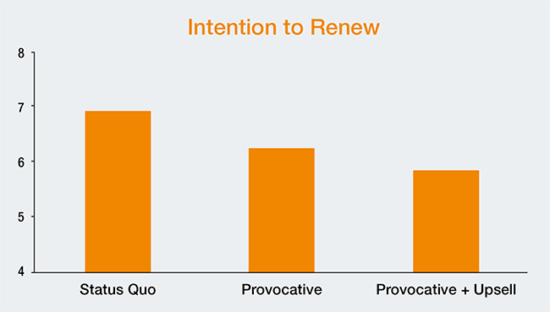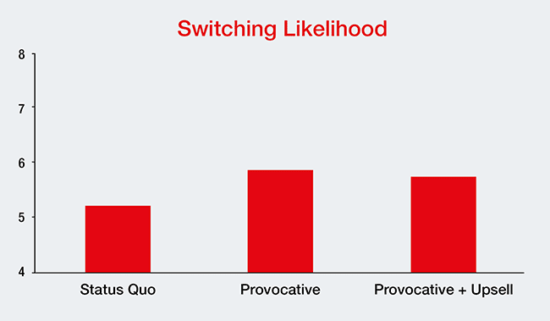Disrupt or defend?
29th January 2017 | Tim Riesterer
Delivering your most effective customer renewal message is your best opportunity to drive profitability. But what should that message be?

When I last wrote for this publication, my piece addressed a messaging and skills approach for succeeding in what many B2B salespeople regard as the hardest but most rewarding type of sale: new customer acquisition. The skills approach I outlined in that piece dealt with messaging and selling effectively when you are the outsider trying to get in.
One of the most important takeaways in connection with this acquisition conversation is that, oftentimes, your biggest enemy isn’t who you think it is. Contrary to what many sellers think, the other competitors in your industry aren’t the biggest threat to your success. In reality, when you’re the outsider trying to acquire a new customer, your most powerful adversary—the force you most need to defeat—is your buyer’s status quo bias. That is, their aversion to doing something different from what they’re doing today.
Your story, then, isn’t so much about why a net new prospect should choose you. It’s about why that prospect should change—why they should make a leap and leave their current situation in exchange for something different. The heart of your “why change” acquisition story—as I argued, and as our research confirmed—is a message based on what I call your prospect’s “unconsidered needs.” These unconsidered needs are the challenges or missed opportunities your buyer doesn’t yet know about. By identifying and introducing unconsidered needs, you create the urgency to change by revealing inconsistencies in their current situation and demonstrating clear contrast between your solutions and their status quo.
That, in a nutshell, is the disruptive story that defeats “status quo bias,” which you need to tell when you’re the outsider.
But what about when you’re the insider? What if you are the status quo, the incumbent, and the story you need to tell isn’t “why change?” but “why stay?” What if you already have significant market share, and a big part of your success depends on getting great customers to renew with you?
For many salespeople or account managers, executing well in this conversation is essential to hitting your numbers and driving growth. Also, for many companies, renewals are often where the customer starts to generate more profitability, as suppliers frequently spend considerable money to acquire and over-serve customers to achieve customer satisfaction during the initial contract.
Just as I laid out a research-backed approach for telling a more compelling acquisition story, I’m also about to share new study results that focus on developing, delivering and reinforcing the most effective renewal message.
To accomplish this, my company, Corporate Visions, once again contracted with Dr Zakary Tormala, an expert in messaging and social influence, to conduct a pair of studies designed to assess the effectiveness of various types of renewal messages. (Separately, Dr Tormala is a professor of marketing at the Stanford Graduate School of Business).
“Why stay?” – testing for the most compelling renewal message framework
At a time when provocative messaging and insights-based approaches are sweeping the sales world, it’s easy to think these methods are universally applicable, and will serve you equally well in any selling situation. But how effective do these disruptive approaches hold up when you already have, and you’re trying to protect, existing customer relationships? Does your “why stay” message framework need to differ from your “why change” story approach?
That’s what we wanted to test. Here’s how we set up the study.
How effective do disruptive approaches hold up when you already have, and you’re trying to protect, existing customer relationships?
Methodology
The online experiment included 402 individuals. At the outset of the study, they were instructed to imagine that they ran a small business and that about two years ago they’d signed up with a 401(k) benefits* provider to help promote their company’s retirement plan to employees. The hope was that getting more employees signed up would boost employee satisfaction with the company and increase employee retention.
Participants were told to imagine that two years ago, only 20% of their employees subscribed to the 401(k) plan. In the two years since then, participation had risen to 50%, a positive sign, but still short of the 80% goal. During that same period, employee retention rates had improved, but it was difficult to say how much of that could be attributed to the company’s promotion of its 401(k) benefits plan.
Participants were then asked to imagine they were trying to make a decision about whether they should renew with their current provider or look elsewhere. When participants clicked through to the next screen, they received a message, or “pitch”, from their existing provider. What participants didn’t know is that they were being randomly split up and assigned to one of three different pitch conditions.
The opening paragraph was the same for all participants, but then each message differed in important ways:
- Status quo reinforcement condition – In this condition, participants received an encouraging description of how the plan was working to date, and how the company was making progress toward its ultimate goals. They then received an additional message designed to reinforce the causes of the status quo bias (ie causes that make people averse to change). This additional piece emphasized how much effort went into selecting the current provider originally, while highlighting the risks and costs associated with changing providers now.
- Provocative pitch condition – In this second condition, the message documented the results to date before introducing a new idea that challenged their current approach. In this case, the message noted that it can be harder to move from 50% to 80% participation than it was to move from 20% to 50%. Making that move, the message continued, might even require different tactics, such as switching the plan from an “opt-in” approach to an “opt-out” one that defaults all employees into participating in the 401(k) plan. The provider would help make this change, pushing the company toward achieving its goals.
- Provocative pitch with upsell – This message was the same as the provocative pitch above, with one small difference: the message offered participants a series of online tools for employees that ostensibly would increase their engagement in reaching their goals. These new tools would add 5-15% to overall programme costs, with an anticipated payback in less than 12 months.

Figure 1: Intention to renew across three different messages.
After hearing their respective pitches, participants answered a series of questions designed to assess their reactions to the messages and measure the persuasive impact within the renewal context. These questions focused on participants’ intention to renew, attitudes toward the vendor, likeliness to switch, and vendor credibility. Each was accompanied by a scale ranging from 1 to 9, labelled such that higher scores indicated higher values on the dimension assessed. Responses to these questions were then averaged to form a composite index for each dimension.
Across all measures, the status quo reinforcement message outperformed the provocation and upsell messages by statistically significant degrees. The message that documented success and reinforced the status quo bias showed a:
- 13% increase in intentions to renew, compared with the two provocative messages (see Figure 1). To measure this, participants were asked how likely they would be to renew with their current provider and how likely it was that they would stick with that provider.
- 9% boost in positive attitudes, compared with the other two message conditions. Participants had much higher impressions of the provider than in either of the messages that challenged their current approach with a new idea.
- 7% boost in credibility, compared with the two provocative conditions. Participants answered three questions that assessed credibility, trustworthiness and the level of confidence instilled by the provider’s message.
Provocative messaging could actually backfire when it comes to convincing customers to renew with you
Perhaps most importantly, participants also answered three questions designed to measure to what extent they intended to switch providers or look elsewhere after hearing each pitch. Once again, there was a statistically significant effect. But, as illustrated in Figure 2, this time it went in the opposite direction, with the study finding that participants in the provocative conditions were 10% more likely to switch or shop around than participants in the conditions that reinforced the status quo.

Figure 2: Likelihood to switch across three conditions.
If there’s one overarching takeaway to draw from this study, it’s that the provocative messaging approaches seemingly so in fashion today might not hold up as well within a renewal selling context. (Unlike in our previous research, which showed these approaches will be effective in a net new customer acquisition selling scenario). In other words, provocative messaging could actually backfire when it comes to convincing customers to renew with you.
In his study “The Psychology of Doing Nothing: Forms of Decision Avoidance Result from Reason and Emotion,” Christopher Anderson proposes four causes of the status quo bias that tend to hold people back from committing to change.
To tell a compelling renewal story, companies will want to consider how to reinforce these causes – and thus reinforce themselves as the status quo.
Below are the four causes of the status quo bias, and some commentary on how to apply them to your renewal message:
- Preference stability – Remind customers of the long, difficult process they went through to make their original decision to choose you. People prefer to keep their previous decisions and preferences understood as valid and stable. You must deliberately reinforce
- Perceived cost of change – Take them through the startup costs and other resource requirements that were invested but, now been returned through improved performance and are now part of the ongoing operating budget. People believe change costs more than staying them same, and you’ll do well to reinforce that.
- Anticipated regret and blame – Remind them of how much progress they have made to date. Also, recount for them how much effort has it taken to ramp up the new solution, onboard everyone, manage the changes, and get the implementation running well? Another change risks stalling or taking a step backwards and only leaves them vulnerable to these same potential failure points again.
- Selection difficulty – Concede that most other solutions on the market provide similar capabilities, and that the competitors haven’t changed significantly since the original purchase decision. People struggle to change if they don’t see enough contrast between alternatives. And, while it may seem counter-intuitive, there is less pressure to prove competitive differentiation during a renewal discussion. In fact, it may be more optimal to demonstrate that you are more alike.
Research into customer lifecycle messaging
In a recent article in this journal we covered research looking at the concept of developing and delivering a more effective customer acquisition or “why change” story (see “Have you thought about this?” in the International Journal of Sales Transformation 1.2, July 2015, pp 38-39). It spoke to the power of introducing “unconsidered needs” to disrupt the status quo.
After that work was published, companies kept asking us what if anything would be different in communications with existing customers, as they sought to ensure their business. This article examines brand new research focused on finding the most effective approach to the customer renewal or “why stay” story.
We are also enthusiastically announcing an extension of all this research with a new research project in partnership with Warwick Business School professor, Nick Lee, and this journal. The goal of that forthcoming research is to address the next tricky conversation that salespeople will inevitably have, which is: “What’s the best way to communicate a price increase or “why pay” story? The results of that study will appear in the next issue of this publication.
Meanwhile, we’ve also put together an industry survey that deals with important themes connected to communicating price increases. We invite you to take the survey here (link is case-sensitive): http://cvi.to/PriceSurvey
A framework for renewal messaging: how to reinforce the status quo when you are the status quo
While our research revealed that reinforcing the four causes of the status quo bias are superior to provocative messaging in a renewal setting, we wanted to get more specific and prove an exact framework that works best. That was the focus of a follow-up study.
Methodology
For this online experiment, also conducted with Dr Tormala, we recruited 380 individuals. The participants were given the exact same hypothetical situation as those in the previous study. But this time, all of the pitches focused on reinforcing the four causes of status quo. Instead we manipulated certain parts of the message to test various frameworks for any statistically significant differences.
The first dimension we tested was whether the renewal framework should document performance results before or after messaging that reinforces the status quo.
The second dimension we tested was whether the framework should give more or less explicit detail on any ongoing improvements made to the solution during the initial terms of the contract.
All told, the study included four different message conditions, each with a different combination of information order and level of detail.
If there’s one overarching takeaway to draw from this study, it’s that the provocative messaging approaches seemingly so in fashion today might not hold up as well within a renewal selling context
The questions participants answered after receiving each pitch were designed to assess switching intentions, willingness to pay, trust and message quality. Overall, the data indicated that: (1) documenting results before reinforcing the status quo was a more effective strategy than reinforcing the status quo before documenting results, and (2) offering more detail about recent advances was a better strategy than offering less detail. More specific results are described below.
Switching intentions
First, to assess switching intentions, three questions asked participants how likely they would be to shop around for other providers, to switch companies and try a new provider, and to consider discounted offers from competitors. Responses to these questions were averaged to form a composite index of switching intentions. Results indicated that although order did not have a statistically significant effect on switching intentions, there was a tendency for participants to be less likely to switch when the provider documented results first as opposed to reinforcing the status quo first.
Moreover, there was a statistically significant effect of detail on switching intentions. Participants indicated that they were less likely to switch or shop around for a new provider when the message contained more explicit detail. On average, participants were 7.36% less likely to switch in the more- compared with less-detail condition.

Willingness to pay
Participants also reported how much they would be willing to pay monthly to renew with their current provider. In this case, responses were provided on a scale ranging from 0-100% of their current rate, in 10% increments. This measure revealed a significant effect of the order manipulation, such that participants were willing to pay 6.59% more when the provider documented successful results before reinforcing the status quo (73.61% of their current rate) rather than vice versa (67.02% of their current rate). There was no effect of level of detail on willingness to pay.
How do you most effectively reinforce the status quo? Below is the situation, as well as the winning and losing message conditions, from the study.
Situation
Imagine you’re running a small business and, two years ago, you decided that you needed to improve your employee satisfaction and retention rates, because your turnover is too high and it’s expensive to have to hire and train new people.
You took several steps, including signing up with a vendor who could help promote your 401k retirement plan to your employees. You hoped that increasing employee participation would boost employee satisfaction and reduce turnover. At the time, only 20% of your employees subscribed to the 401k, plan, and you hoped to get that to 80%, which is a benchmark for businesses with world-class employee retention rates.
You went through a rigorous process to evaluate providers. Most were similar, but you found a company that seemed like they could meet your needs. You signed a two-year contract and now it’s time to renew with them, select another vendor, or go back to handling it yourself.
The vendor did a nice job kicking off the programme and creating buzz. You had expected them to do more to promote the programme the entire two years, but they generally provided good customer service to you and your employees.
Employee participation improved to 50% (from 20%), but you fell short of your goal of 80% participation. Employee retention rates also have gone up, but it’s hard to say how much of that was because of the change in how you handled and promoted 401k plans. You’ve met recently with some of the other providers you originally considered to see what’s changed in the last two years, and make an informed decision. They’ve all made improvements and introduced new features. Some have appealing capabilities, but nothing that stands out. Keep this in mind as you listen to your current provider tell you why you should continue doing business with them.
Winning condition
Document results – You have made great progress on your goals over these last two years. You’ve seen 401k participation grow from 20% to 50%. Your employee satisfaction scores are up, and you’ve said some employees have even taken the time to thank you for the changes you’ve made. In addition, your employee retention rates have started to improve, which you said was the ultimate goal of making these changes.
Preference stability – When you signed up two years ago, you really did your homework and looked at a lot of options before getting your entire team to come to a consensus and choose our company. It was a long process that involved a lot of people, but you ultimately arrived at a big decision to bring this program on board.
Anticipated regret/blame – As you look at making a renewal decision, it’s important to realize that you are at a critical point in this journey and that it’s important to maintain momentum to achieve your ultimate participation and retention goals. Any change to the programme at this point could create an unnecessary risk of losing the positive gains you’ve made.
Perceived cost of change – Not to mention that bringing in another vendor would require you to invest time in getting them up to speed and money on implementation costs and other changes that you won’t have to spend if you continue working with us.
Selection difficulty – We’ve also continued to update and tweak your programme over the last two years to make sure you are keeping pace with anything else available in the market today. Specifically, you will get two new features designed to help improve your goals of employee participation and satisfaction:
The first is a monthly report that shows how many tax dollars your 401k participants saved versus those who aren’t in the 401k. You can share this with your employees monthly to provide a gentle nudge to get into the programme for the tax benefits. Second, we’ve also added a new smartphone app with retirement planning calculators and budgeting tools to help your employees make more informed decisions, and feel like they’re making progress on their goals.
You’re making great progress. Stick with our programme for another two years, and I know you’ll get to your 80% participation goal and further increase your employee retention rates.
Losing provocative condition
Documented results – You have made great progress on your goals over these last two years. You’ve seen 401k participation grow from 20% to 50%. Your employee satisfaction scores are up, and you’ve said some employees have even taken the time to thank you for the changes you’ve made. In addition, your employee retention rates have started to improve, which you stated was the ultimate goal of making these changes.
Provocative insight – This is great progress, but we’ve seen that for many companies it can be harder going from 50% to 80% than it was going from 20% to 50%. The latest research shows that it’s no longer just about improving communications of the benefits of contributing to the 401k. In fact, companies that achieve world-class participation rates are actually “flipping” their approach to enrolment. Instead of the traditional “opt-in” approach to enrolment where people sign up for the plan, these companies are automatically enrolling their employees in the 401k plan, and requiring them to fill out a form to “opt-out” of participating.
New and improved solution – We can switch your programme over to this “opt-out” approach and waive any additional set-up and administrative costs in exchange for renewing our partnership for the next two years. We’re looking forward to working with you over the next two years to adopt this approach and reach the world-class goals you’ve set.
Trust
Participants also indicated how trustworthy they found the provider to be. On this item, there were statistically significant effects for both order and level of detail. Participants reported greater trust in the provider when the provider’s message first documented successful results (rather than reinforcing the status quo) and when it offered more rather than less detail about recent advances. On average, the “results first” messages outperformed the “status quo first” messages by a margin of 5.49%, and the more detailed messages outperformed the less detailed messages by a margin of 4.72%.
Message quality
Finally, participants rated the provider’s message on several scales assessing how thorough it seemed to be, how much evidence it contained, and how unique it was. There was no effect of order on these ratings, but there was a significant effect of level of detail. Participants rated the message as higher quality (more thorough, more evidence-based, more unique) in the more detail condition compared with the less detail condition. On average, the more detailed messages outperformed the less detailed messages by 6.36% on this index.
Across multiple dimensions, the “document results first” and “more detail” messages proved more persuasive than the “status quo first” and “less detail” messages, respectively. Although there were differences across measures in terms of which effect reached statistical significance, the overall pattern of results points to the greater effectiveness of documenting results at the outset of the message and using more explicit detail in highlighting recent advances when employing a message focused on reinforcing the status quo.
Stay tuned: This research is a kick-off study for an additional piece of research to be conducted with (and unveiled in) this publication. The follow-up study will focus on one of hardest conversations salespeople ever have: How to effectively communicate price increases with customers.



